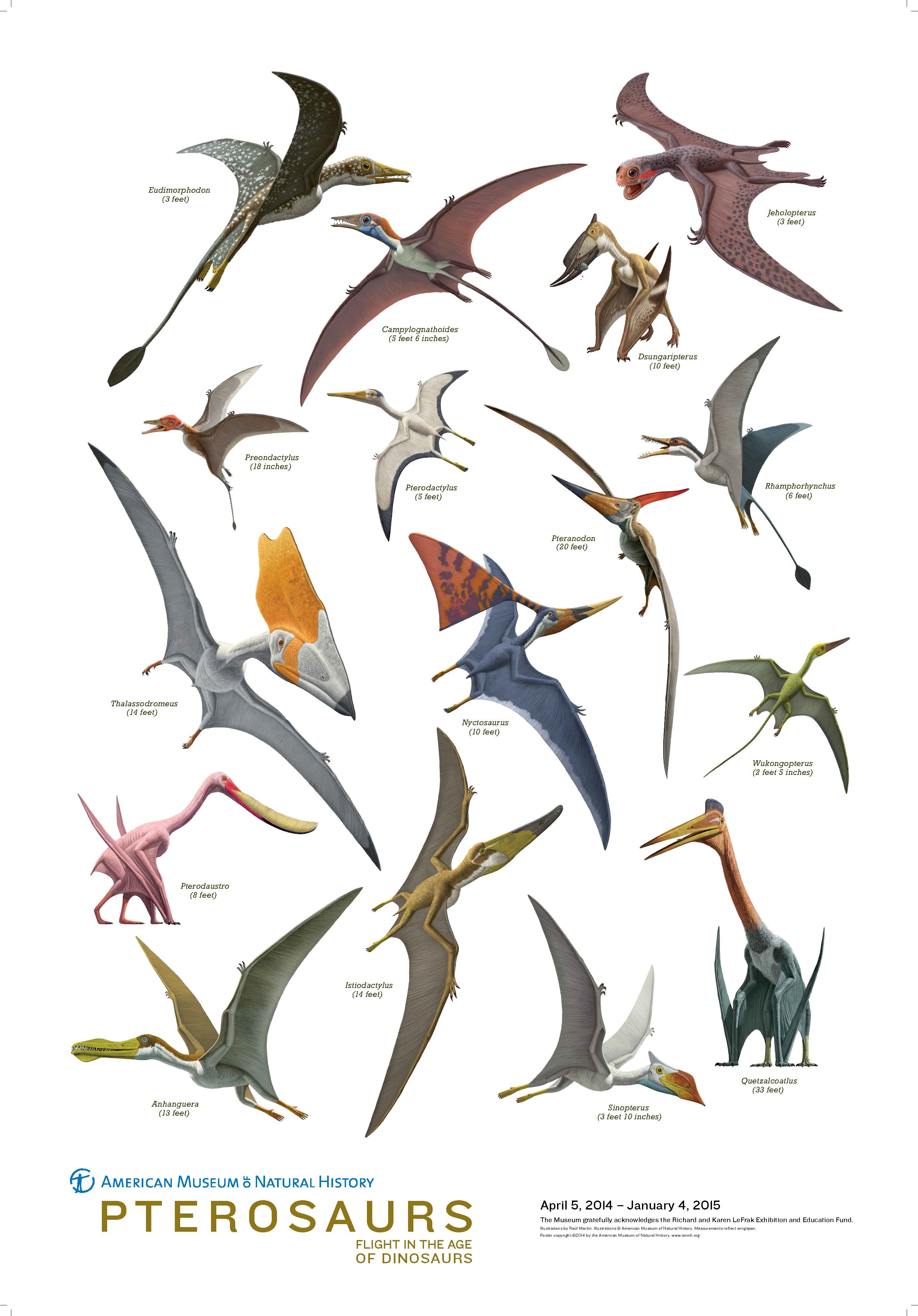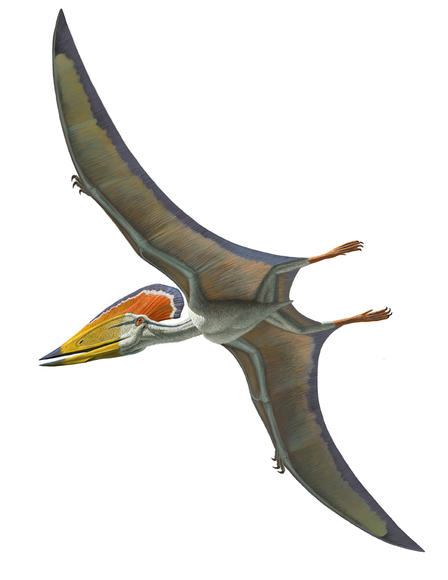
Pterosaurs ("winged reptiles") were flying reptiles
of the Mesozoic Era, and the first of only
three vertebrate groups known to have evolved
active flight. Pterosaurs first appear in the paleontological
record about 225 million years ago,
during the late Triassic Period, and persist to the
terminal Cretaceous extinction event, about 65
million years ago.Pterosaurs are recognized as being
members of the group Archosauria, a group
including thecodonts, crocodiles, birds, and dinosaurs.
While pterosaurs were contemporaries to
the great Mesozoic dinosaurs, and often confused
with them, pterosaurs were not dinosaurs.
The origin of pterosaurs is a subject of great debate.
Pterosaurs share some physical characteristics
in the hips and legs with early dinosaurs. It
has also been suggested they could run bipedally
and took to the air by the energy-consuming
method of running and flapping their wings. Another
view suggests pterosaurs pursued a treedwelling
way of life, and developed parachuting,
gliding, and eventually flight as an energy-saving
byproduct of their lifestyle. Another debate surrounds
whether pterosaurs were warm-blooded
or cold-blooded creatures. Some fossil remains
suggest certain pterosaurs may have been covered
with short, thin fur, or even very fine feathers.
This, combined with the energy-consuming
activity of flying, leads many researchers to favor
warm-blooded pterosaurs.
The first pterosaur fossils were discovered in
the Solnhofen Limestone Formation in Germany,
in 1784. Pterosaur fossils range in size from those
of Pterodactylus, whose forty-centimeter wingspan
was about that of a modern song bird, to
Quetzalcoatlus, whose fifteen-meter wingspan was
as big as a modern private aircraft wing. Pterosaurs
had light, bony skeletons made of hollow, tubular
bones, and compact bodies to improve wing support.
The pelvis and hind limbs were small, yet
long and slender when compared to the fore limbs
and shoulders. The fore limbs were exaggerated
in comparison to the hind limbs, with their great
length derived from the extended fourth finger,
which alone supported the flight patagium. The
pterosaur patagium was a soft membrane thought
to have been tougher and thicker than a bat's
wing, and divided into three anatomical segments.
One short segment stretched from the torso to the
elbow end of the humerus; a second, longer segment
stretched from the radius and ulna and the
bones of the wrist and palm; and the third, longest
segment was an elongated fourth finger supporting
the wing membrane to its tip. The segments of
the wing were progressively longer as they got
farther from the trunk. The first, second, and third
fingers were not involved in membrane support
but were free to grasp and cling; there was no fifth
finger. This "finger-wing" configuration is quite
different from the wing support structure seen in
bats and birds.
Types of Pterosaurs
Pterosaurs are generally divided into two groups:
The rhamphorhynchoids first appear during the
Triassic, and the pterodactyloids appear some 108
million years later. The Rhamphorhynchoidea
had teeth, long tails, short metacarpals, long fifth
toes, and a head held in front of and slightly above
the torso. The Pterodactyloidea had no tail or fifth
toe, an elongated metacarpus forming the largest
support structure of its wing, a more "birdlike"
neck posture with the neck curving in an S-shape
entering the cranium frombelow rather than from
behind, holding the head higher above the torso,
and many had evolved toothless beaks. Pterodactyloidea,
such as Pteranodon, also evolved extreme
head crests, and like many later pterosaurs,
lacked well- developed teeth. Many other pterosaur
fossils exhibit well-developed and specialized
teeth: Eudimorphodon and Dorygnathus had
teeth designed to spear and hold prey; Dsungaripterus
had bony jaws and broad, flattened teeth to
winkle out shellfish and snails; and Pterodaustro
had a comblike array of teeth, ideal for sieving
plankton.
The majority of pterosaur bones have been recovered
from marine sedimentary rock deposits,
suggesting these flying reptiles took advantage of
the atmospheric updraft conditions of gentle and
constant breezes along shorelines, as well as the
abundant food of the marine environment.
Pterosaur aerodynamics and flight characteristics
have been studied in great detail, and they suggest
pterosaurs were active, wing-flapping fliers,
but also better gliders than are most modern bird
species. Pterosaur anatomy suggests they were
able to glide and soar over great distances and for
extended periods of time under calm conditions,
but that they were not well adapted for staying
aloft under turbulent conditions. It is estimated
that the pterosaur Pteranodon, who represents one
of the high points in pterosaur evolution with a
wingspan of over seven meters, could soar at
speeds in excess of 30 kilometers per hour, continue
gliding aloft for nearly twenty hours, and possibly
cover distances of over 750 kilometers without
landing.
The greatest number of pterosaur bones have
been recovered from the Kansas marine chalk deposits
of North America. Over eight hundred
skeletal fragments have been found there. While
many of the remains suggest these Kansas
pterosaurs died nonviolently, other bones suggest
the pterosaurs were eaten by marine reptiles. Apparently,
pterosaurs swooping low to snatch prey
fromthe ocean's surface were often in turn preyed
upon by larger marine reptiles or sharks.
Pterosaur Facts
Principal Termsarchosaurs: diapsid reptiles whose skeletal evolution distinguishes them from the diapsid lepidosaurs
Mesozoic Era: the middle era of the Phanerozoic eon, 250 million to 65 million years ago
patagium: a soft, flexible membrane
Other popular Animals
Photo Gallery of - Pterosaur








 Animalia Life
Animalia Life